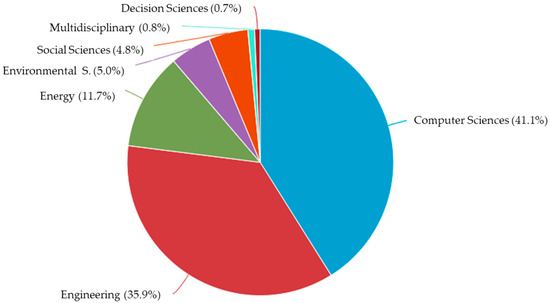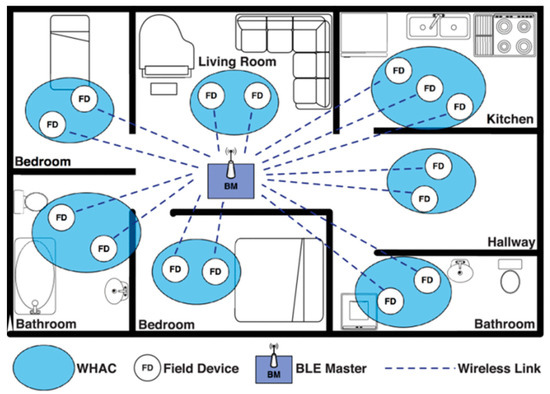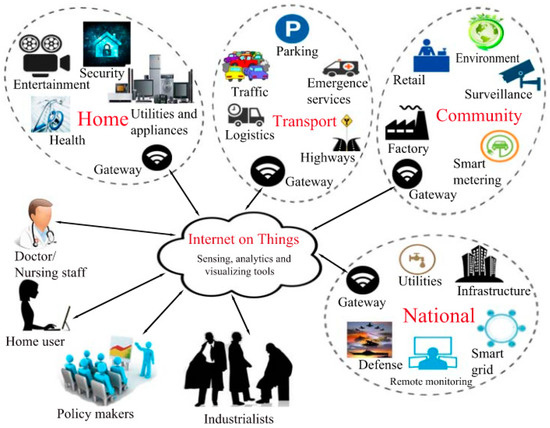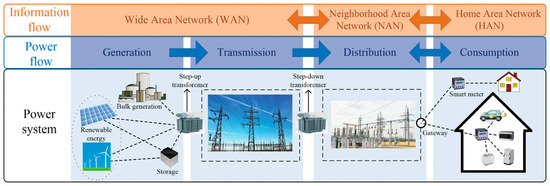The Smart Grid is a modern intelligent network adapted to a new global paradigm. Intelligent systems bring together energy and information and communication technologies, improving performance, quality, generation, transmission, distribution, and marketing services.
Regarding the influence of intelligent networks in the transformation of human activities, it is essential to know the resources and systems of sensors, IoT and, in general, the devices that improve people’s quality of life. Today, there is a growing need for society to take care of its health by integrating the use of technology. Human Activity Recognition (HAR) allows monitoring of people’s quality of life and, in time, more features and functionalities emerge in this area, relying on a wide repertoire of hardware and software components. Proof of this is the implementation of several solutions in indoor environments, which capture the data generated from people’s interactions with an intelligent environment. Data collected from heterogeneous sensors implemented in intelligent environments or from sensors connected to the body (wearables) are stored in datasets and the information obtained from intelligent devices is integrated into a larger set, the intelligent network that brings together an environment, a community, a city, and, in general, a joint strategy to improve the quality of technology and life in our society.
- smart grids
- sensors
- human activity recognition
- internet of things
- literature review
Nota: Estimado autor, los siguientes contenidos son extractos de sus artículos. Son editables. Y la entrada estará en línea solo después de que los autores la editen y la envíen.
1. Introducción
El diseño de instalaciones eléctricas en un entorno determinado supone un reto para la mejora de la gestión energética en nuestra sociedad. En el año 2019, uno de los principales objetivos de la Conferencia de Naciones Unidas sobre Cambio Climático – COP25 – celebrada en Madrid fue el desarrollo y transferencia de tecnología para lograr una evolución sostenible del consumo energético a nivel mundial, con el principal objetivo de reducir las emisiones de gases de efecto invernadero [ 1 ].
Hoy en día, existe una necesidad creciente de que la sociedad cuide su salud integrando el uso de la tecnología y numerosos estudios e esfuerzos de investigación ofrecen trabajos interesantes sobre este tema [ 2 , 3 ]. La tecnología que diseñamos y construimos en entornos inteligentes debe ser una tecnología centrada en el clima; es decir, los avances tecnológicos deben impulsar el consumo de energía a través de fuentes renovables, controlar y medir el consumo, reducir las emisiones de gases de efecto invernadero y alertar y prevenir el consumo inadecuado de energía. En definitiva, las tecnologías domésticas deben integrar los procesos de eficiencia energética y sostenibilidad medioambiental.
Las redes eléctricas y energéticas en general se diseñan, planifican e instalan con el objetivo de proporcionar un suministro eléctrico de alta calidad a los usuarios. Esta energía recorre enormes distancias para llegar al punto final, que es el consumidor. Las personas son fundamentales en este escenario y juegan un papel clave en la interacción con las redes energéticas a la hora de diseñar mejores instalaciones y mejorar la calidad.
Smart Grid es una red inteligente moderna adaptada a un nuevo paradigma global. Los sistemas inteligentes combinan la energía y las tecnologías de la información y la comunicación, mejorando el rendimiento, la calidad, la generación, la transmisión, la distribución y los servicios de marketing [ 4 , 5 ].
En cuanto a la influencia de las redes inteligentes en la transformación de las actividades humanas, es fundamental conocer los recursos y sistemas de sensores, IoT y, en general, los dispositivos que mejoran la calidad de vida de las personas. Hoy en día, existe una necesidad creciente de que la sociedad cuide su salud integrando el uso de la tecnología. El Reconocimiento de Actividad Humana (HAR) permite monitorear la calidad de vida de las personas y, con el tiempo, surgen más características y funcionalidades en esta área, apoyándose en un amplio repertorio de componentes de hardware y software. Prueba de ello es la implementación de varias soluciones en ambientes interiores, que capturan los datos generados a partir de las interacciones de las personas con un ambiente inteligente [ 6]. Los datos recopilados de sensores heterogéneos implementados en entornos inteligentes o de sensores conectados al cuerpo (wearables) se almacenan en conjuntos de datos [ 3 ] y la información obtenida de dispositivos inteligentes se integra en un conjunto mayor, la red inteligente que reúne un entorno, un comunidad, ciudad y, en general, estrategia conjunta para mejorar la calidad de la tecnología y la vida en nuestra sociedad.
En 2010, la Conferencia de las Partes, el órgano supremo de toma de decisiones de la Convención Marco de las Naciones Unidas sobre el Cambio Climático, estableció el Comité Ejecutivo de Tecnología (TEC) con el objetivo de acelerar y mejorar el desarrollo y la transferencia de tecnología climática. Este comité está compuesto por 20 expertos que representan a países desarrollados y en desarrollo. El Comité Ejecutivo de Tecnología analiza los problemas de la tecnología climática y desarrolla recomendaciones de políticas equilibradas, ayudando a los países a acelerar la acción sobre el cambio climático ( Figura 1 ). El Comité Ejecutivo de Tecnología reúne a una serie de instituciones, organizaciones no gubernamentales, expertos gubernamentales, las Naciones Unidas y otros [ 7 ].

En 2018, la Comisión Europea publicó el documento: “Un planeta limpio para todos”. Una visión estratégica europea a largo plazo para una economía próspera, moderna, competitiva y climáticamente neutra, en la que presentó una estrategia para la transición a una economía de cero emisiones netas en 2050. Según la Comisión Europea, el sistema energético del futuro integrará los sistemas y mercados de la electricidad, el gas natural, la climatización y la movilidad, con redes inteligentes que sitúen a los ciudadanos en el centro [ 8 ].
La tecnología, y su desarrollo, no solo es una herramienta eficaz en la lucha contra el cambio climático, sino que también es un mecanismo esencial para la evolución de la vida en la tierra y la mejora de la salud humana y la condición del planeta en general. El diseño tecnológico en este contexto será clave para el futuro de la humanidad.
El diseño tecnológico de los entornos donde vivimos, nos movemos y trabajamos también debe ser objeto de un análisis detallado relacionado con la tecnología climática. Los seres humanos producimos y emitimos gases de efecto invernadero como producto de nuestra actividad; por eso debemos diseñar espacios sostenibles y eficientes.
El diseño de hogares y casas inteligentes debe adaptarse a la normativa existente sobre ingeniería eléctrica y automatización. Estas regulaciones se han vuelto obsoletas y en ocasiones no son adecuadas para un diseño climático eficiente y sostenible. Como suele ocurrir, la investigación y la innovación tecnológicas evolucionan más rápido que las regulaciones [ 9 , 10 ]. Con base en lo anterior, en este trabajo nos centraremos en estudiar la interacción entre los sistemas inteligentes integrados en entornos humanos y el reconocimiento de las actividades humanas que se pueden observar en dichos espacios de manera multidisciplinar, con el propósito de llevar a cabo un análisis sistemático y revisión exhaustiva de la investigación existente en este campo y aportando nuevas ideas a estos avances [ 11 , 12].
2. Resultados
2.1. Análisis cuantitativo
Comenzamos este punto indicando que se ha elegido un marco temporal de años completos, de 2015 a 2019. En el año 2020, a la fecha de finalización de este trabajo, hay algunas referencias muy interesantes relacionadas con nuestra investigación, pero porque no cumplen con el parámetro de tiempo, no han sido incluidos en las tablas de datos y análisis cuantitativos y cualitativos. En las bases de datos analizadas se han localizado un total de 29 trabajos que podrían cumplir los objetivos de esta investigación. Se puede destacar el trabajo realizado por Dileep [ 34 ], ya que ofrece un análisis completo y detallado de todos los componentes de la red inteligente, sus aplicaciones, beneficios y oportunidades, teniendo en cuenta también la importancia de los usuarios.
We continue analysing Table 3, where it can be seen that 481 results were obtained in the first block of data extraction, while applying the corresponding filters resulted in a lower number, 180 results. The first column indicates the name of the analysed database, the second column, Results, indicates the number of gross results obtained. The columns for Filter 1, Filter 2, and Filter 3 present the screening results. In the last column, Revised Results, all 180 results are included.
Table 3. Summary of search results and filters.
| Search String Model | Library | Results | Filter 1 | Filter 2 | Filter 3 | Revised Results | Duplicates | Revised Results Final | |
| IEEExplore | 129 | 74 | 72 | 0 | 72 | IEEExplore + WOS + SCOPUS | 3 | ||
| WOS | 34 | 23 | 22 | 0 | 22 | IEEExplore + WOS | 9 | ||
| SCOPUS | 318 | 165 | 155 | −69 | 86 | IEEExplore + SCOPUS | 6 | ||
| Total | 481 | 262 | 249 | −69 | 180 | 18 | 162 | ||
By filtering out the works that are repeated over several databases, we obtain the final number of articles to be reviewed in a qualitative way, this being 162.
As we can see in Figure 3, representing the results from the Scopus database, there is a remarkably large percentage of articles in the areas of Computer Science (41.1%) and Engineering (35.9%). These data coincide approximately with those of the WOS and IEEExplore databases.

Figure 3. Analysis of the Scopus database results by area.
2.2. Qualitative Analysis
2.2.1. Analysis Strategy 1. SG Architectures, Models and Studies
There are numerous sources that propose their work as an analysis of architectures, models, prototypes, and studies on SGs and their relationship with communication systems for the automation of low-voltage electrical networks in intelligent indoor environments.
If we analyse the documents [35,36,37,38,39,40,41,42,46], we find relationships between the fields of work studied. For example, a multi-zone control scheme for data and energy flow management was designed and evaluated in [35] using real data on load demand and energy prices from the household power grid. A reduction in energy demand was deduced.
In the IEEExplore database, some works in the field of SGs, sensors, and applications in the intelligent home have been selected to be studied [43,44]. In [43], educational training in SGs and the use of advanced sensor technologies are analysed. This document presents a test bed in the smart home based on the project-based learning (PBL) pedagogical model for undergraduate education. The proposed test bench enables undergraduate students to gain key skills in smart network-related topics such as peak demand flattening, real-time price response, wireless sensor networks, machine learning, pattern recognition, embedded system programming, user interface design, circuit, and database design.
There is some interesting research in the Scopus database, where [45] proposes a new energy management approach to smart homes that combines a wireless network based on Low-Energy Bluetooth (BLE) for communication between home appliances with a Home Energy Management (HEM) scheme. People’s comfort is taken into account when it comes to intelligent and integrative energy management. Figure 6 shows a proposal for a home network with sensors based on Bluetooth.

Figure 6. Proposal for a home network with sensors based on Bluetooth [45].
2.2.2. Analysis Strategy 2: Modelling Control Theory, Mathematical Analysis, Block Diagrams, Differential/Integral Equations
If we propose an analysis of the works that contain research on control theory modelling, mathematical analysis, etc., that are an essential part of developments in the field of study of SGs concerned with integrated sensors in the home, we find the following references that carry out similar studies: [51,52,53,54,55,56,57,58,59,60].
One interesting aspect that needs to be addressed is that which is referred to in [53] and which in this era has grown considerably—the field of cyber security. In this document, we analyse IoT-enabled cyberattacks, which can be found in all fields of application.
Three objectives are proposed: (1) To evaluate IoT-enabled cyberattacks with a risk-based approach, (2) to identify hidden and subliminal attack routes enabled by IoT against critical infrastructures and services, and (3) to examine mitigation strategies for all fields of application. In analysing SGs and their application to HAR, we must take cyber security into account.
Wazid [56] studies a new efficient protocol for remote user authentication in the implementation of IoT and also evaluates the formal security verification of the scheme by automatically validating the Internet Security Applications and Protocols Tool (AVISPA) through simulation to verify whether it is secure (Figure 7).

Figure 7. Network architecture Internet of Things (IoT) [56].
2.2.3. Analysis Strategy 3: SGs and Their Application to HAR and ADL
The results of a study carried out in 19 Scottish households in which energy consumption and the perception of SGs in relation to energy were controlled by means of sensors and equipment installed in these homes, mainly in homes inhabited by older people, are presented in [61]. This applies a social scope to the study, a case that interests us, since one of the objectives of the work we are analysing is social involvement, applying the study and its results to households and elderly people in future applications.
In reference [63], an analysis of civil applications, prototypes, and possibilities for future integration of the wireless sensor is carried out by means of a bibliographic review, discussing human life and welfare. It classifies the use of wireless sensors in different disciplines and makes specific mention of those related to human health and human use for HAR.
We can observe that in the filtering of documents and research works, in this case for studies related to SGs, sensors, and devices that facilitate, study, or research human activities, mobility in intelligent environments, etc., we find few works that interrelate these subjects.
We would have to apply other search parameters to find further research in this field, but we wanted to analyse the fact of direct studies with people, with mobility within the home of people with disabilities, elderly people, and other types of search vectors being largely absent when searching for the terms SGs or intelligent networks.
This will lead us to the conclusion presented at the end of the work, in which we analyse this fact.
2.2.4. Analysis Strategy 4: Simulation of Intelligent Environments with Sensors in the Home, Data Control Architecture, Complex Computer Systems
In [67], the relationship of SGs assisted by IoT is addressed: Technologies, architectures, applications, prototypes, and directions for future research. It is an interesting and comprehensive work on the more specific field of SGs and their relationship with IoT (Figure 8). However, we still do not see a more direct relationship with the social and human spheres, in order to link this SG strategy with its direct application to HAR and ADL. In this work, the research is focused on structuring the sources of SGs and their relationship with IoT, but it covers a large number of vectors related to the generation, transmission, and marketing of electrical energy, where the home and the application of sensors for the improvement of people’s quality of life is scarcely touched upon.

Figure 8. Smart Grid architecture featuring power systems, power flow, and information flow [67].
Data privacy and security for the home area network connected to the network using IoT is discussed in [64]. This paper looks into secure data flow and customer data privacy during critical and emergency operations. Data are available in real time with minimal delay in transit time. Devices are continuously monitored for vital and emergency services. User energy consumption data are intended to be available in the cloud and also on customized electronic devices in real time.
Aroua [68] proposes a new framework for household energy control in smart homes using Cognitive Radio Sensor Networks (CRSN).
Andrade, in his work [65], develops a management methodology that analyses the behaviour of wireless networks within an intelligent home through a simulation, taking into account several parameters or restrictions such as coverage distance and capacity. The smart grid infrastructure is described, and a mathematical model is proposed to minimise the distance of the sensors to the access points within the area under consideration.
In [70], optimal energy demand data management for smart homes is studied. The system can support near real-time decisions for 10,000 customers, each of which has 10 sensors with only 35 basic machines running free software in the cloud.
The European project COMPOSE [66], Collaborative Open Market to Place Objects at your Service, analysed the inclusion of sensors inside a supermarket that track the location of shopping carts as customers move through the store, which can then be combined with shopping information. These data can be used to help position the product on the supermarket shelves. This type of research does provide learning to be implemented in the development of HAR studies, however this document does not discuss this aspect, but focuses rather on business production.
The review of communication protocols or algorithms, which study the design and implementation of environments with SG sensors and to a large extent are studies in the field of energy demand, electrical networks, are an important area of research among the following documents analysed: [73,74,75,76,77].
There are also studies that address the role of 5G technology in the IoT [78] and in some others, such as [84], different vectors are studied, such as temperature and CO2 level and its control, to find out how people move around in a home or how they consume. This study developed a methodology to determine individual household occupation patterns using ubiquitous household sensors.
The characteristics were derived from sensors that monitored electrical energy, dew point temperature, and CO2 concentration indoors and merged using the Dempster–Shafer method of combining evidence. A hidden Markov method was then applied to predict the occupancy profile during the day. It is an evidence-based approach.
Wang and others, in [79], discuss a wireless sensor network (WSN) applied in the intelligent network communication system, which is low-cost, low-energy dissipation, self-organising, and highly flexible. This article presents WSN applications in condition-based maintenance, smart metering, and smart homes, among others.
Nguyen [86] makes a practical implementation of an intelligent home system based on a wireless sensor network for the integration of SGs. It presents a SG home gateway hardware design. The SG Home Gateway can control electrical devices according to the programming schedule or data received from the control centre. In addition, it proposes a simple wireless network topology based on the star routing protocol for the SG Home Network. The results of the final demonstration present a SG Home Gateway prototype.
Es interesante notar que la relación entre SG, sensores, HAR y ADL tiene múltiples aplicaciones y diferentes puntos de vista, los cuales están interrelacionados y tienen perspectivas de diseño y simulación que auguran un futuro muy prometedor en beneficio de la salud de las personas, aún más. así que durante esta pandemia en la que hemos sufrido bloqueos y donde la salud y la tecnología juegan un papel cada vez más importante.
This entry is adapted from the peer-reviewed paper 10.3390/su12208662
